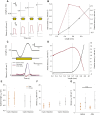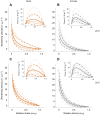Male and female syringeal muscles exhibit superfast shortening velocities in zebra finches
- PMID: 38563308
- PMCID: PMC11058336
- DOI: 10.1242/jeb.246330
Male and female syringeal muscles exhibit superfast shortening velocities in zebra finches
Abstract
Vocalisations play a key role in the communication behaviour of many vertebrates. Vocal production requires extremely precise motor control, which is executed by superfast vocal muscles that can operate at cycle frequencies over 100 Hz and up to 250 Hz. The mechanical performance of these muscles has been quantified with isometric performance and the workloop technique, but owing to methodological limitations we lack a key muscle property characterising muscle performance, the force-velocity relationship. Here, we quantified the force-velocity relationship in zebra finch superfast syringeal muscles using the isovelocity technique and tested whether the maximal shortening velocity is different between males and females. We show that syringeal muscles exhibit high maximal shortening velocities of 25L0 s-1 at 30°C. Using Q10-based extrapolation, we estimate they can reach 37-42L0 s-1 on average at body temperature, exceeding other vocal and non-avian skeletal muscles. The increased speed does not adequately compensate for reduced force, which results in low power output. This further highlights the importance of high-frequency operation in these muscles. Furthermore, we show that isometric properties positively correlate with maximal shortening velocities. Although male and female muscles differ in isometric force development rates, maximal shortening velocity is not sex dependent. We also show that cyclical methods to measure force-length properties used in laryngeal studies give the same result as conventional stepwise methodologies, suggesting either approach is appropriate. We argue that vocal behaviour may be affected by the high thermal dependence of superfast vocal muscle performance.
Keywords: V max; Isovelocity; Muscle performance; Song learning; Vocal performance.
© 2024. Published by The Company of Biologists Ltd.
Conflict of interest statement
Competing interests The authors declare no competing or financial interests.
Figures





Similar articles
-
Increasing Muscle Speed Drives Changes in the Neuromuscular Transform of Motor Commands during Postnatal Development in Songbirds.J Neurosci. 2020 Aug 26;40(35):6722-6731. doi: 10.1523/JNEUROSCI.0111-20.2020. Epub 2020 Jun 2. J Neurosci. 2020. PMID: 32487696 Free PMC article.
-
Optimal shortening velocities for in situ power production of rat soleus and plantaris muscles.Am J Physiol. 1997 Sep;273(3 Pt 1):C1057-63. doi: 10.1152/ajpcell.1997.273.3.C1057. Am J Physiol. 1997. PMID: 9316427
-
Syringeal vocal folds do not have a voice in zebra finch vocal development.Sci Rep. 2021 Mar 19;11(1):6469. doi: 10.1038/s41598-021-85929-5. Sci Rep. 2021. PMID: 33742101 Free PMC article.
-
Adaptations for extremely high muscular power output: why do muscles that operate at intermediate cycle frequencies generate the highest powers?J Muscle Res Cell Motil. 2023 Jun;44(2):107-114. doi: 10.1007/s10974-022-09640-2. Epub 2023 Jan 11. J Muscle Res Cell Motil. 2023. PMID: 36627504 Free PMC article. Review.
-
Muscle mechanics: adaptations with exercise-training.Exerc Sport Sci Rev. 1996;24:427-73. Exerc Sport Sci Rev. 1996. PMID: 8744258 Review.
Cited by
-
Vocal registers expand signal diversity in vertebrate vocal communication.Philos Trans R Soc Lond B Biol Sci. 2025 Apr 3;380(1923):20240006. doi: 10.1098/rstb.2024.0006. Epub 2025 Apr 3. Philos Trans R Soc Lond B Biol Sci. 2025. PMID: 40176520 Free PMC article. Review.
-
JiSuJi, a virtual muscle for small animal simulations, accurately predicts force from naturalistic spike trains.bioRxiv [Preprint]. 2025 Jun 18:2025.06.16.659528. doi: 10.1101/2025.06.16.659528. bioRxiv. 2025. PMID: 40667037 Free PMC article. Preprint.
References
Publication types
MeSH terms
Associated data
Grants and funding
LinkOut - more resources
Full Text Sources

